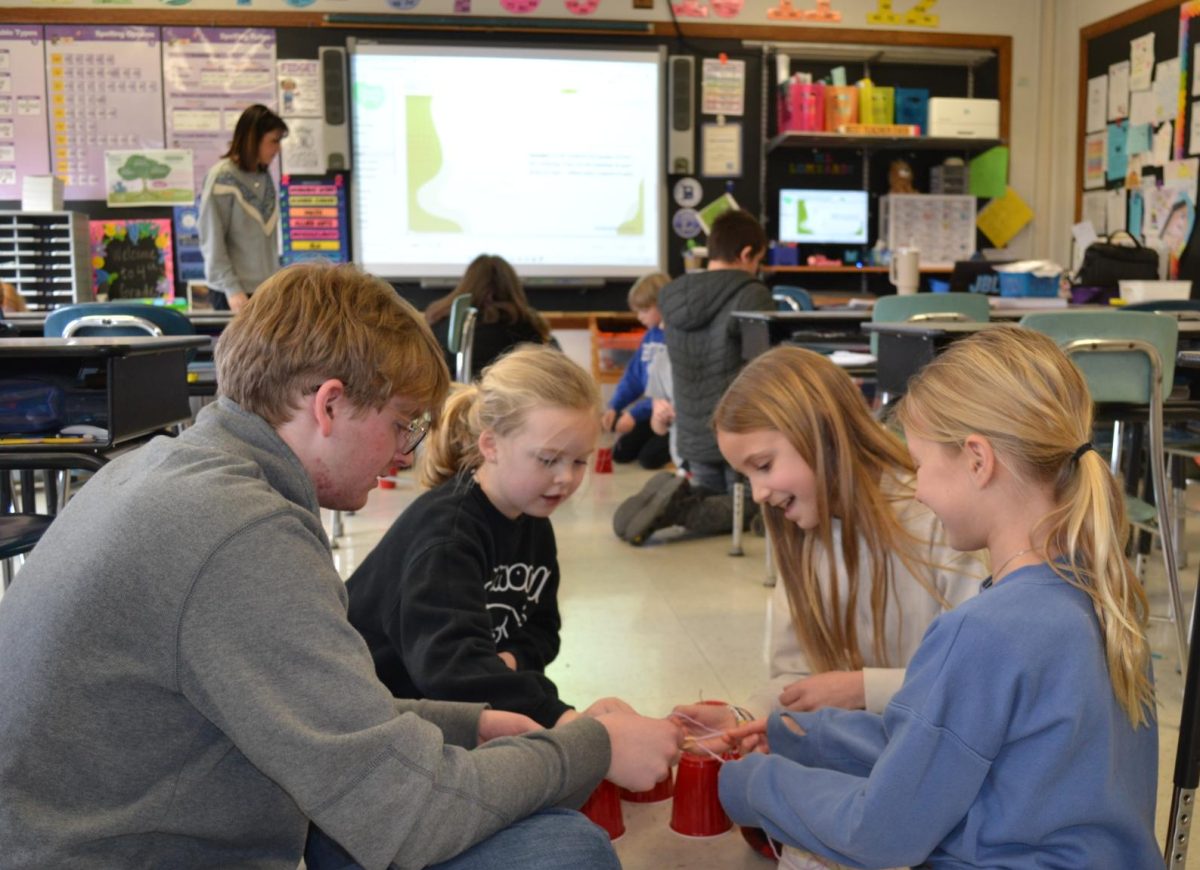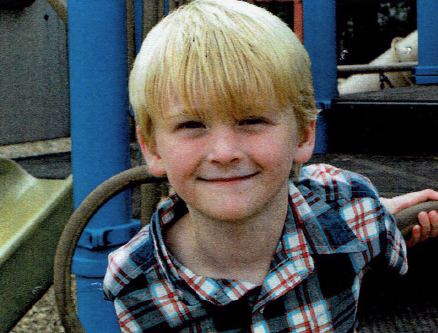
Emma Schiff
Junior Cyrus Turner stacks cups with rubber bands alongside students from Julie Lombardi’s fourth grade class.
Whether it be a sports season or summer camp, it’s easy to divide one’s life up into chapters. Once one has ended, it’s rare to get the chance to open it again. Elementary school was the last chapter of my life before COVID-19 sent the world into quarantine, so when the opportunity arose to spend an afternoon in a Cassingham classroom, there was no choice but to take it.
It only seemed fitting I revisit my third-grade teacher, Julie Lombardi, and her class. Some of my most vivid elementary school memories are from her classroom, and while she now educates fourth-graders, it was the perfect place to relearn the rhythm of Cassingham Elementary School.
I entered the building during lunch and was immediately hit with a wave of nostalgia. Each corner had a memory associated with it; I was able to point out my first locker as well as the route I would take when pulling the lunchbox cart for my class. The walls are still lined with the art of former students, but they now include pieces made by current high schoolers. Even though the teachers in each classroom had shifted, it was immediately apparent the energy in the elementary school was the same.
My appearance in front of the fourth-graders was far from discreet; I stuck out like a sore thumb. I introduced myself, much like a new student on the first day of school, before we jumped into the daily schedule. Taking my seat next to a kid named Eli, we listened to a read-aloud of “I Survived the Destruction of Pompeii, 79 AD” by Lauren Tarshis. Lombardi projected the book onto her Smartboard using an ELMO, allowing her students to follow along while she spoke.
I loved seeing the buzz of energy from the kids while they heard about the eruption of Mount Vesuvius. Each student showed an eagerness to learn. It was good to be reminded that there was a time when I did not know the definition of “tunic” either.
Lombardi said the most rewarding part of being a teacher is watching a student grasp concepts they had struggled with before.
“It’s that ‘aha, I get it’ moment,” she explained. “I think most teachers would tell you that a kid gets this look in their eye.”
The chapter left off on a cliffhanger before we moved onto the next activity: creating brochures about notable mountain ranges. My group members, Noah and Sydney, got busy finding pictures of the Appalachian mountains, which the two of them had done research on the previous few days. After a morning of Honors Precalculus, I had no problem with being designated the role of cutting and gluing photos.
Working on the brochure was a reminder about how well the elementary school fosters creativity in their students. Many of the fourth-graders were passionate about art, and the walls of Lombardi’s classroom were lined with posters made by her current students. One kid named Addy even made me a drawing, thanking me for spending time with the class. It brought me back to the pride I felt having a teacher hang up something I’d worked hard on; one of my proudest achievements in elementary school was having my design chosen for the cover of the yearbook in fifth grade.
As we transitioned into quiet reading time, I was relieved to see staple online programs like Lexia and Raz Kids are still present today. Although I tried to log back into my old account, I was unsuccessful in my efforts. I suppose I am a faux fourth-grader.
Fifth grade was the last grade I experienced in its entirety before COVID-19. The current students in Lombardi’s fourth-grade class were 2 or 3 years old at that time. While the effects of the pandemic are not as obvious now as they once were, Lombardi explained it allowed for the creation of new core values at the elementary school.
“[There has been] a realization of how many roles a teacher plays in a kid’s life, and there’s a respect and a focus on emotional health and safety,” she said. “We value that as much as we value academics.”

The change in policy during the pandemic went hand-in-hand with the removal of IB curriculum in the elementary school, another noticeable change since my days as a Cassingham Cub. It inevitably led to the retirement of certain traditions at the elementary school, including the first-grade project, “Bexlandia,” during which students would build a town out of cardboard and it would be displayed for the rest of the school.
Not every Cassingham tradition was left in the past, however; Lombardi said the fourth-grade market, where fourth-graders sell homemade goods to raise money, is an activity that is still dominant.
“Every kid knows we’re going to do that at the end of the year,” she explained. “It’s like a Cassingham institution.”
Although annual events are important at Cassingham, Lombardi’s class had traditions of their own. Every day, a group of students do the Wordle together and other students play the card game “kemps.” Some kids also draw or play with Magna-Tiles.
I was able to walk from group to group, joining in on each of the different activities. It was reassuring to see there was a combination of games from my own childhood alongside the addition of new games, and the inclusion of Wordle was no surprise considering it grabs people of all ages.
The school day ended with a visit from one of the elementary guidance counselors, who taught us a lesson about cooperation. We were challenged to work together to stack cups using four pieces of string and a rubber band. Even though my group didn’t complete the task in the allotted time, we cooperated and made a strategy together that would’ve likely gotten us there in the end.
The world has changed drastically since I was an elementary school student at Cassingham, but there is something universal about the memories formed at Cassingham Elementary; we have all done Charity Newsies fundraisers, have all explored the dugouts at the back of the field and have all been assigned the job of line leader. It is clear that our elementary schools plant the seeds that make us who we are, and I can already see those same seeds starting to bloom in the personalities of Lombardi’s fourth-grade students.
Elementary school, Lombardi explained, is something that sticks with both students and teachers forever.
“Once you’re our students, you always are,” she said.
Published March 2025. Digitized 2025.